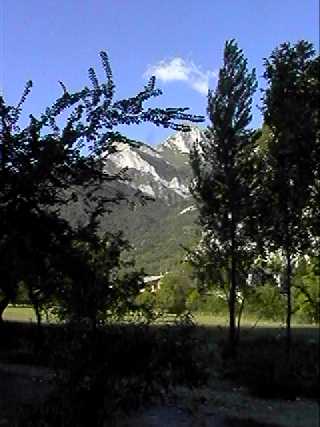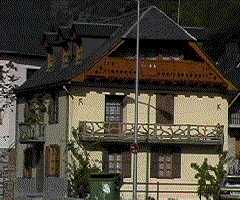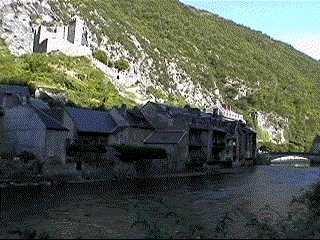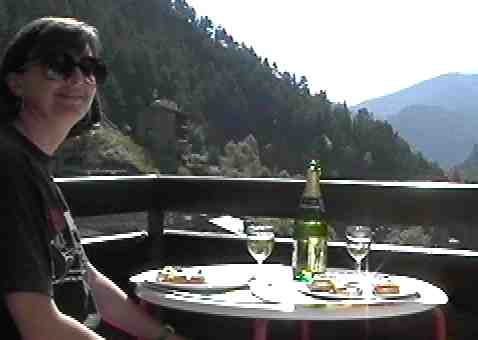A Short Tour of the Pyrenees
|
We followed the Rio Esera north and wound our way along the precarious little
road through the Congosto de Ventamillo, where the river has cut a deep
gorge through the limestone. From there we climbed the Coll de Fadas and Coll d'Espina
before turning north up the valley cut by the Riu Noguera. The hiddend paradise of Val d'Aran has a lot in common with Andorra. For centuries,
it was protected by its surrounding mountains. Finally, in 1924, when hydroelectric
power was in demand, a road was cut across
the Puerta de la Bonaigua and in 1950 a 5.24 km tunnel was opened to the Benasque.
The hiddend paradise of Val d'Aran has a lot in common with Andorra. For centuries,
it was protected by its surrounding mountains. Finally, in 1924, when hydroelectric
power was in demand, a road was cut across
the Puerta de la Bonaigua and in 1950 a 5.24 km tunnel was opened to the Benasque.
The local language is Aranés, a form of Occitan, as is Catalan, which is still spoken by the local inhabitants. We saw signs in three languages, Aranés, Catalan, and Castillian. We hesitated at the Parador overlooking Vielha and the entire valley, but decided it was early to stop for the night. We descended into Vielha and headed north along the Rio Garona towards France. The Treaty of the Pyrenees of 1659 divided the lands between France and Spain according to which way the rivers flowed. By rights, this should be France, but it is Spain and we never did find a good reason why France didn't lay claim to it.  We passed by the winding road that climbs 18 kilometers over the Col del Portillon
and descends into Luchon. We could go back there for the night, if we wished.
We passed by the winding road that climbs 18 kilometers over the Col del Portillon
and descends into Luchon. We could go back there for the night, if we wished.
At Les, we noted the interesting balcony railings, made from carefully selected tree branches. They seem to be a distinguishing feature of many buildings in the Vall d'Aran. 
We followed the river down into France, where it became the Garonne, on its way to the Bay of Biscay. Immediately across the border, which is no longer obvious, the houses change from colourful to dull gray, and the language changes from Aranés to French.  We followed the Garonne north for a half an hour, passing through tiny villages,
hugging the river's edge, with their boulangeries and supermarchées, .
Finally, at St Béat, only a few kilometers from where we had passed in the
rain on Saturday morning, we turned around and headed back south into Spain.
We followed the Garonne north for a half an hour, passing through tiny villages,
hugging the river's edge, with their boulangeries and supermarchées, .
Finally, at St Béat, only a few kilometers from where we had passed in the
rain on Saturday morning, we turned around and headed back south into Spain.
Although there were many attractive small hotels in Vielha and the small villages on either side of the town, we settled on the Parador at Arties. They quoted us a reasonable price (pts 11,000) for the night, and the place was clean, modern, and new. Well, modern at one end, anyway. The other end blended into the old tower which was probably no more than 3 or 4 hundred years old.  In the little square in front of the tower is a statue of Portola dating from the
17th century. Was this the same Portola who explored the area around San Francisco,
and gave his name to the Portola Valley?
In the little square in front of the tower is a statue of Portola dating from the
17th century. Was this the same Portola who explored the area around San Francisco,
and gave his name to the Portola Valley?
After checking out the menus of the restaurants around the tiny village of Arties, we decided to "stay in" and eat in the dining room of the Parador. Coming down to dinner at about 8:30, we found the doors locked and the restaurant dark. But the front desk assured us that it would open soon, so we went back to our room for a short while before redescending. From the plentiful menu we selected Crabe Bisque and local patés to start. Jane had a trout grilled on a piece of slate, served sizzling. I had the Magret of Duck in a bittersweet sauce, delicious. It was all washed down with a 1989 bottle of Marquis de Cacéres, which we managed to get only after sending back the 1994 that was offered. After all, the menu listed a 1989! Dessert was crèpes, topped with a custard, very much like crema catalana, with a layer of caramelized sugar burnt on top. Yes! If you go to Vall d'Aran, stay at the Arties Parador and enjoy.  A pair of Pyrenees bears make their home in Arties. There are now only 7 of these
bears left. Even in 1985, there had been a few bears roaming the Pyrenees, including
the northern parts of Andorra. But now, they are practically all gone. I am
not sure that those of us who enjoy hiking the remote mountain trails really miss their
presence, when it comes down to it.
A pair of Pyrenees bears make their home in Arties. There are now only 7 of these
bears left. Even in 1985, there had been a few bears roaming the Pyrenees, including
the northern parts of Andorra. But now, they are practically all gone. I am
not sure that those of us who enjoy hiking the remote mountain trails really miss their
presence, when it comes down to it.
Tuesday morning, we drove back into Vielha and wandered about the town, poking into souvenir and craft shops. At the home of a ceramicist, we picked up some small vases of dried flowers, crafted to look like leather bags with buttons. Something to decorate our flat and remind us of our visit. We visited the museum in Vielha because the tourist office told us that was where we needed to go to buy the poster of Pyrenees flowers, that we liked. As it turned out, we couldn't buy the poster there, but the museum was well worth the visit. We learned a lot about how the area was originally populated, and how it developed over the centuries. The valley, like all of the Pyrenees, had been inhabited since the bronze age by shepherds who are known for the megaliths they left behind. The Roman historian, Polibi, tells of the Arenois, who inhabited the valley when Hannibal drove his elephants through the area in the third century BC, on his way to Italy. In Roman times, there were ten times as many people living in the valley as live there now. Vielha was an important town in the region, and many Roman ruins are left from that era. Looking at a map of the Roman roads, it is only the ones that follow the valleys through the Pyrenees that aren't straight. From the twelth century, the Arenais people attached themselves to Catalonia, despite the geographic advantages of a French connection. They formed a small independent republic, around the same time as Andorra became independent. Their government was by a council of heads of households, drawn by lot using bags of beads. The chest containing these bags, and the agreements the Arenais held with the neighbouring kings was on view in the museum. Edified by the visit to the museum, we parted from the pretty town and followed the valley up through the Puerto de la Bonaigua, 2092 meters above sea level, and down the Noguera Pallaresa river toward Sort. If we knew the way, and had a four wheel drive jeep, we could have taken the smugglers short cut from there to Andorra and come in the back way via Pal. But we took the long road around via La Seu d'Urgell and arrived back in Andorra in the middle of the afternoon. President Chirac of France, Coprince of Andorra, was visiting the country, and making his way around each of the Comus. We were afraid this would cause road blockages and long waits, but it had the opposite effect. All parked cars were cleared from his route, and lots of people stayed home to avoid the "congestion". As a result, we sailed through town and made it home in time for a nice cup of tea. |

Sunday Lunch on our own balcony
September 21 1:00pm